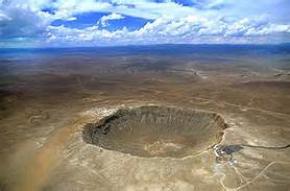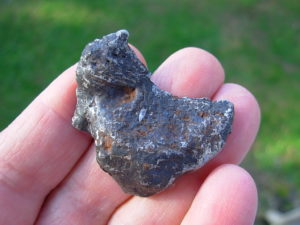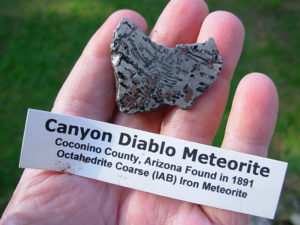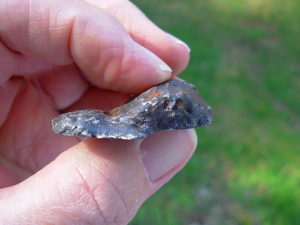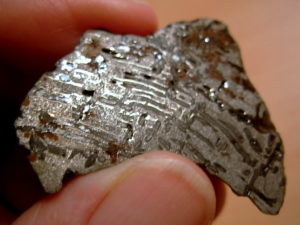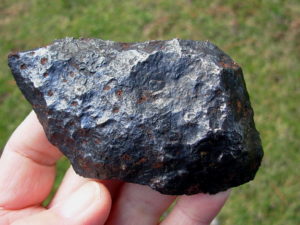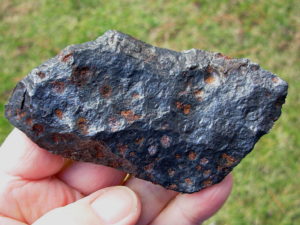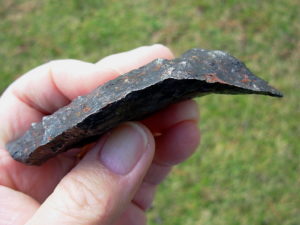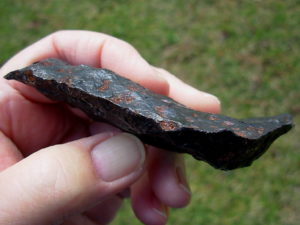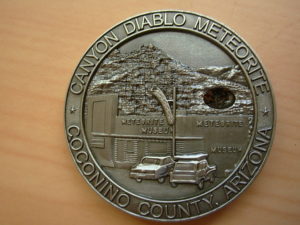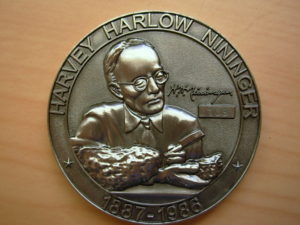Canyon Diablo Meteorites
Canyon Diablo Iron Meteorites
Find / Fall: Find - 1891 Location: Arizona, USA Classification: Iron, IAB-MG Total Known Weight: 30 Metric Tons
The Canyon Diablo Meteorite comes from the plains around the famous Meteor Crater in northern Arizona, 35 miles east of Flagstaff. The meteorite is named after the nearest landmark, which is the winding, dry, Canyon Diablo which is located three miles west of the impact site. Canyon Diablo Meteorites are among the most historically significant meteorites available to collectors. Made of nickel-iron with inclusions of graphite and other minerals they are classified as Coarse Octahedrite Iron Meteorites. The smaller fragments show the effects of being torn apart by the tremendous crater-forming explosion. Thin sharp edges and twisted metal are typical features of the meteorites from Meteor Crater. Hunting meteorites near Meteor Crater has been banned for a long time now.
Meteor crater was formed approximately 49,000 years ago when a huge iron-nickel meteorite, most likely a break off piece of an asteroid, streaked through the Northern Arizona sky, impacting in the desert plains and leaving a crater 4000 feet across and 700 feet deep. The meteorite is estimated to have been about 160 feet across and weighing several hundred thousand tons. The earth was struck with an explosive force in excess of 20 million tons of Dynamite.
Settlers discovered meteor crater in the 1870s. It was at first thought to be a volcanic formation. In the early 1900s the theory was given that Meteor Crater was caused by a meteorite impact. Daniel Moreau Barringer believed that a huge meteorite weighing millions of tons must be buried below the floor of the crater. A mining claim was filed and drilling operations began in 1905 in search of the meteorite. Drilling continued until 1929 when it was determined that there was no meteorite to be found. A meteorite of this size, moving at the speed required to create such a crater in the Arizona plains, would have generated enough energy and heat to vaporize most of the meteorite.
Amphiboles crystallize into two crystal systems, monoclinic and orthorhombic. Amphiboles are minerals of either igneous or metamorphic origin; in the former case occurring as constituents (hornblende) of igneous rocks, such as granite, diorite, andesite and others. Those of metamorphic origin include examples such as those developed in limestones by contact metamorphism (tremolite) and those formed by the alteration of other ferromagnesian minerals (hornblende). Pseudomorphs of amphibole after pyroxene are known as uralite.
The name amphibole (from the Greek word amphibolos meaning 'ambiguous') was used by René Just Haüy to include tremolite, actinolite, tourmaline and hornblende. The group was so named by Haüy in allusion to the protean variety, in composition and appearance, assumed by its minerals. This term has since been applied to the whole group. Four of the amphibole minerals are among the minerals commonly called asbestos. These are: Anthophyllite, Riebeckite, Cummingtonite/Grunerite series, and Actinolite/Tremolite series. The Cummingtonite/Grunerite series is often termed Amosite,or Brown Asbestos and Riebeckite is known as Crocidolite or Blue Asbestos. These are generally called Amphibole Asbestos.
Item # MCD11150861
31g Canyon Diablo Etched End Slab Meteorite

31g Canyon Diablo Etched Meteorite A hard to find specimen from the famous crater in Cochino County, Arizona. This piece is from an Old Stock Collection. Slight Surface Rust. straight view looks silver and black(top left). Angled view with any light source shows brilliant silver shiny chrome looking lines (top right).
This specimen weighs 1 oz (31g) and measures 1.6 x 1.3 x 0.44 inches (41 x 35 x 11.2mm)
Item # MCD121335611
300g Canyon Diablo Meteorite with regmaglypts
$235.00

300g Canyon Diablo Meteorite with regmaglypts A hard to find specimen from the famous crater in Cochino County, Arizona. This piece is coated with mil-comm TW25B (synthetic, non oily protectant) gun oil to prevent any future rust formation.
This specimen weighs 10.6 oz or 0.66 lbs (300g) and measures 4 x 2.1 x 0.64 inches (102.9 x 53.5 x 16.4mm)
Item # MCDC11153214
Canyon Diablo Meteorite/Harvey Nininger Commerative Coin No 139 of 300

Canyon Diablo Meteorite/Harvey Nininger Commemorative Coin No 139 of 300
Canyon Diablo Meteorites are a "must have" specimen for a collector. Having this coin displayed next to your specimen adds eye appeal, class and a sense of history to your display. The front of the coin bears the face of H.H. Nininger, as seen on the back cover of Nininger's book Find A Falling Star, uncontested as the scientist who brought meteoritics to the mainstream and leaving behind a legacy that is unmatched. The reverse shows the famous American Meteorite Museum in Sedona as seen on page 222 of Find A Falling Star. Inset on the reverse is a piece of Canyon Diablo meteorite. The coin set was limited to a run of only 300. It is a 2" zinc base coin with an antique brass finish. The meteorite pieces are small an have developed a coat of rust as can be seen in the left photograph. You can add your own small piece if you like. !

